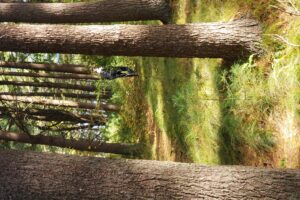I wake to the golden brilliance of morning. Sunshine streams through the bedroom window. There is no wind. And it is almost warm. Something is wrong. The weather forecast said miserable. Michael tells me there has been an unexpected break in the weather, but it won’t last long. Miserable and messy will be back later this afternoon.

Special Guests are Expected…
Because it is Wednesday—and since we have been here Wednesdays have been rainy, windy, and cold—it is the day I assign myself to wash the bedding, take care of our laundry, and give the house a once over with a Swiffer Sweeper and duster.
It seems wrong to break the pattern today, especially since Lisa and David will be arriving late this afternoon to attend a lecture at Pilgrim Hall, given by an archaeologist who headed a dig adjacent to their property this summer. They plan to leave too quickly and fly out early tomorrow.
I want their tiny bit of homecoming to be warm and welcoming, and it will be Lisa’s first time seeing her new chairs. Along with the lecture, and dinner at a restaurant, David loves afterward, I plan a cocktail hour with tiny hors d’oeuvres and an easy breakfast tomorrow morning. All of which require prep this morning.

So, I treat today like any other day I expect guests. And all of the prep is something I love to do. However, since everything is an experiment, I can’t help but worry and wonder if it will be any good.
Perfection
Finally, I need to sit for a while. I join Michael on the top deck, basking in the glory of the day. The weather is perfect. The first sign of perfection we have seen since stepping foot in Plymouth the evening we arrived.
Sitting here discussing the weather, Michael relays what he learned from the weatherman this morning. Normally the Boston area (including Plymouth) gets less than 14 days of measurable rainfall in October. With two days left before the month’s end, projections are for 21 days of rain in 2019: one of the wettest Octobers in quite some time. Thank goodness for the raincoat I bought for our English vacation several years ago. It is my uniform this year.
Cocktail Hour
Lisa texts me saying they are 15 minutes away. I turn on the lights in the living room. Click on the fire. Pop the hors d’oeuvres in the oven and pop the cork on the champagne.

Cocktail hour is Shrimp Cornets and a Champagne Cocktail. The easiest, most refreshing cocktail you can devise. The recipe for Shrimp Cornets is available at this link: Shrimp Cornucopia Recipe
To make a Champagne Cocktail. Chill a bottle of brut champagne, prosecco, or cava till it is very cold. Slice a lemon into 1/8-inch circles. Cut the circles into half-moons. Place one sugar cube in the bottom of a champagne glass. Sprinkle two drops of Angostura Bitters on top of the sugar cube. Place a half-moon lemon slice in each glass. Pour in the ice-cold bubbly of your choice. Serve!
Pilgrim Hall


Dr. David Landon
There is a full house at Pilgrim Hall tonight. Michael feels we shouldn’t be here. We are taking up two seats where local history buffs should be sitting. But—we keep our seats and pay close attention as Dr. David Landon noted archaeologist—with creds as long as my arm—talks about excavation efforts on the Plymouth Colony house on Burial Hill. He is self-effacing, knowledgeable, a bit funny, and entertaining as he says, “This next slide is a picture of something only an archaeologist could love…”



Reading the Soil
The one thing that I find most fascinating is how they can determine where long decayed homes of wood with wooden post foundations, and wooden fences to protect the colony were built centuries ago. Discoloration of the soil, I discover. And Dr. Landon shows us a picture of just what he means. The lecture lasts longer than the assigned hour—mainly because almost thirty minutes beforehand the audience was seated and eager to listen.

An Archaeologist’s Perspective
After the lecture, pertinent questions are thrown at Landon from throughout the audience. Residents here really care about their history, and they want to know. I love archaeologists. They work in the world of evidence—hard facts gleaned from the soil or artifacts—rather than stories or myths. If they can’t prove conclusively that something is true, they try very hard not to be swept away with enthusiasm for what they wish to be true. I wasn’t so sure about archaeology the first day I arrived, wanting only to know about the people and how and why and what, but I’ve changed my mind.
Breakfast
It is morning too soon, and David and Lisa need to be in an Uber by 9:30 am to get to the airport on time. The overnight breakfast casserole is in the oven and almost done. The cranberry bread is on the table. The coffee is hot.
We have breakfast with friends.



Breakfast in a Hurry
I’ve made many breakfast casseroles in my life, but this one is super easy and very tasty. It is the Pioneer Woman’s Tater Tot Breakfast Casserole. Click on the name of the dish for the recipe.
My old standby Cranberry Bread recipe is hidden deep in the recesses of my computer at home. So I searched for one that I thought would work, needing to make a few substitutions here and there for what I have on hand. This one was surprisingly good, very moist, and not too tart. The recipe is with my substitutions.
Spiced Cranberry Orange Bread
For the Bread:
- 3/4 cup granulated sugar
- 1/3 cup milk
- 2 tablespoons freshly squeezed orange juice
- Zest of 1 large navel orange, grated on the medium holes of a box grater
- 1/2 cup canola oil
- 1 large egg, room temperature
- 1/4 teaspoon cinnamon
- 1/4 teaspoon nutmeg
- 2 cups all-purpose flour, loosened with a wire whisk
- 2 teaspoons baking powder
- 1/4 teaspoon salt
- 2 cups fresh cranberries
- 1 tablespoon all-purpose flour
For the Glaze:
- 1 cup powdered sugar
- 2 tablespoons freshly squeezed orange juice
- 1/2 teaspoon orange or vanilla extract
Preheat the oven to 350 degrees.
In a medium bowl, stir together the sugar, milk, orange juice, zest, oil, and egg.
In a separate bowl, combine the flour, baking powder, spices and salt. Add the dry ingredients to the wet ingredients and stir until just combined.
In a small bowl, toss the frozen cranberries with a tablespoon of flour to coat. Gently fold the cranberries into the batter.
Pour the bread batter into a greased 9″x5″ bread pan. Bake at 350 degrees for 55 minutes. A toothpick inserted in the center of the bread should come out clean. Allow the bread to cool for 10 minutes, then remove the bread to a wire rack to cool completely.
Charlotte’s Note: 5 minutes after you begin to smell the bread, test for doneness. You don’t want to over-bake it and dry it out.
To make the glaze, combine the powdered sugar, orange juice and extract in a small bowl. Mix until it is smooth.
Once the bread is cool, spread the glaze on top of the bread. Slice and serve.









Leave a Reply
Your email is safe with us.